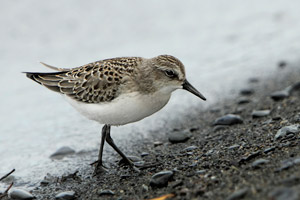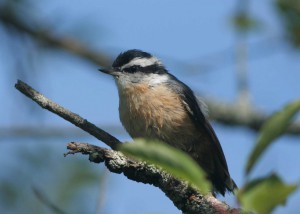Over 360 species of birds have been spotted throughout the Bay of Fundy region, including such endangered species as the peregrine falcon and the piping plover.

The Bay of Fundy is a preferred destination for many birdwatchers, particularly during migration season, due to its prime location along the Atlantic Flyway. Of the two million birds that travel along the Atlantic Flyway each year, three-quarters stop in the Fundy region, making it the most important stopping point along the Eastern seaboard.
Bird Watching Highlights
Amherst Point Migratory Bird Park
A nationally protected habitat, the Amherst Point Migratory Bird Sanctuary is an incredible ecosystem and seasonal home to many species of birds. (Approximately 228 species of birds have been identified within the Amherst Point Migratory Bird Sanctuary.) One thousand hectares of marsh and forest combine to create this important sanctuary. Explore some eight kilometers of trails that wind through this diverse landscape and discover what make the Amherst Point Migratory Bird Sanctuary so special.
Machias Seal Island
Claimed by both Canada and the United States, Machias Seal Island is the seasonal home of approximately 4000 pairs of nesting terns, 500 pairs of nesting razorbills and, the general favorite, 1300 pairs of nesting Atlantic Puffins. Access to this small island is limited and landing is done at one’s own risk as the terrain can be quite slippery and uneven. Machias Seal Island Light is operated by Canadian Coast Guard and the sanctuary is protected by the Canadian Wildlife Service. The only human residents are the island’s two light keeper’s.
Mary’s Point Bird Sanctuary
Mary’s Point is one of the best places along the Bay of Fundy, and perhaps the world, for viewing shorebirds. Hundreds of thousands of semipalmated sandpipers* stop here each summer during their migration from their widespread Arctic breeding grounds to their winter home of South America. Why? Well, quite simply they come here to get fat. Although these cute creatures have over 1000sq. kilometers of the Bay to choose from at low tide, a distinct preference has been shown or Grande-Anse, Starrs Point, Evangeline Beach and, the seemingly most important destination, Mary’s Point.
The birds follow the tide line as it advances and recedes. At high tide the sandpipers roost, but as the waters retreat the birds scurry from one hole to the next. Using sight and their relatively long bills, each sandpiper consumes between 9600-23000 mud shrimp each tide cycle. During their time in Fundy they double their lean weight of only 20 grams, but this is necessary to complete their migration.
After leaving Fundy the sandpipers travel at an average of 60km per hour and their non-stop flight takes approximately 40 to 60 hours, which nearly depletes their entire fat reserve. Of the two million birds that travel along the Atlantic Flyway each year, three-quarters stop in the Fundy region, making it the most important stopping point along the Eastern seaboard. Mary’s Point Bird Sanctuary is protected as a part of the Shepody National Wildlife Area.
*The first semipalmated sandpipers generally do not arrive in Fundy until mid-July.
Robie Tufts Nature Centre
Birdwatchers may enjoy a visit to the Robie Tufts Nature Centre where they have the opportunity to learn about chimney swifts. Open May 15-August 31.
Sackville Waterfowl Park

Visit the Sackville Waterfowl Marsh; twenty-two hectares of water, woods and meadows. Consider taking a “Marshland Mystery Tour” – a two and a half hour walk featuring natural and human history in Tantramar. Long ago this important freshwater marsh was actually a salt marsh, flooded daily by the Fundy Tides, and a significant resource to the Mi’kmaq people who hunted the waterfowl, weaved baskets from the grasses and took nourishment from the cattail roots. When Acadians arrived in the area in the 1600s they ditched and drained the marshes to access the rich soil and use the land for farming. Today, the wetlands are a valued water reservoir, natural filtration and purification system and an important wildlife habitat.
Follow the 3km (2-mile) boardwalk to the edge of the Tantramar Marshes and appreciate the wetlands, home to ducks, songbirds, frogs, muskrats and more. Over 150 species of birds and nearly 200 species for plants have been identified in the Sackville Waterfowl Marsh. Also, on site is a Wildlife Interpretation Centre featuring panels, photos, models and exhibits that further describe the area.
Tantramar Marshes
A Nova Scotia Fundy Shore Eco-Zone, the Tantramar Marshes stretch across the Isthmus of Chignecto; joining Nova Scotia to the Canadian Mainland. Combined of both salt and freshwater marshes, the salt marshes of the bay continue inland for ten kilometres and are then bordered by freshwater marshes. Named Tintamarre, meaning ‘racket’ or ‘din’, by the Acadians that first dyked the land in the 1700’s for the noise made by the local waterfowl, the Tantramar Marshes provide a rich habitat for birds and is an important feeding ground for waterfowl during migration.
june anderson
when are the sandpipers at johnsons mills. what is the best time to see them? cost? Where is johnsons mills?
mike ward
if you have people that would like to come to grand manan for the mid may bird migration i have some cottage reantals in that time frame thanks mike ward
Todd Watts
I stumbled across your site while conducting some research and was happy to see that you mentioned bird watching along the bay. Please know that in addition to the area mentioned, the Fundy Isles region has outstanding birding. As a matter of fact, four Important Bird Areas (IBAs) can be found in the region. A guide to the Southern New Brunswick Birding Trail is about to be released. A guide to birding Saint Andrews and the surrounding area is also available..
Jonathan Robert De Mallie
In having better flocks of birds is a desire grow more fruiting trees. Even Holly etc.etc.. both male and female of that 18f to 1 male
Myryde
I saw two huge flocks traveling east up the bay of Fundy. Incredible!.
Bay of Fundy
Nice. Did you happen to get any good pictures? I’d love to put some on our website and Facebook page.
dolores
hummingbird moth bee in back yard garden today june 20th
deborah LeBlanc
I have had 2 different birds showing up at my feeders . It is the 1st time I have seen them in the past 5 years that I have been in the Fundy region. Nobody from here has ever seen them before.
! has a red head and throat , size: between a sparrow and a cowbird. The other has a brown head and throat , brown feathers on the outer edges and white and black stripes in the middle area on the middle down near the lower back feathers. I was hoping someone could tell me what they are.
Bay of Fundy
I am not a bird expert by any means, but if you have some pictures I might be able to get an expert to look at them.